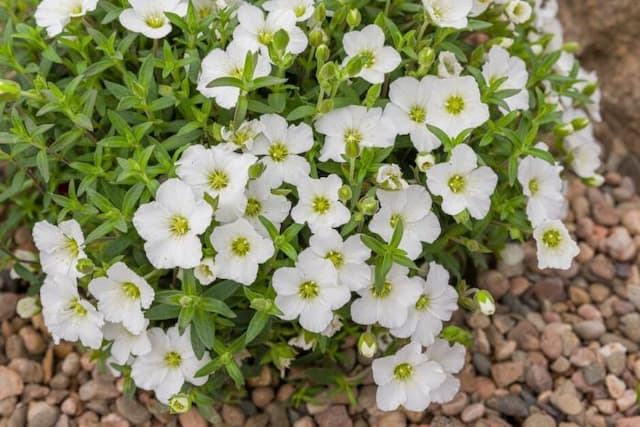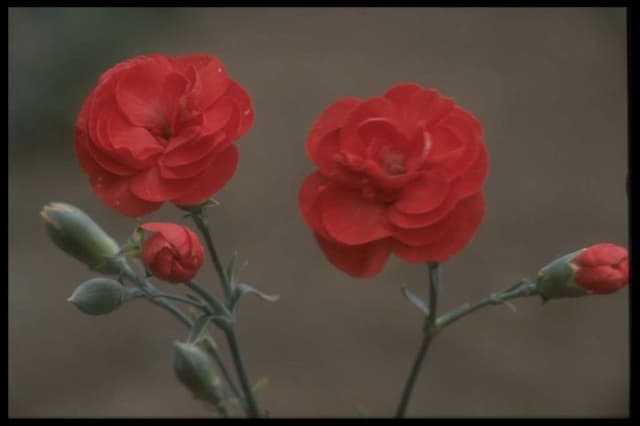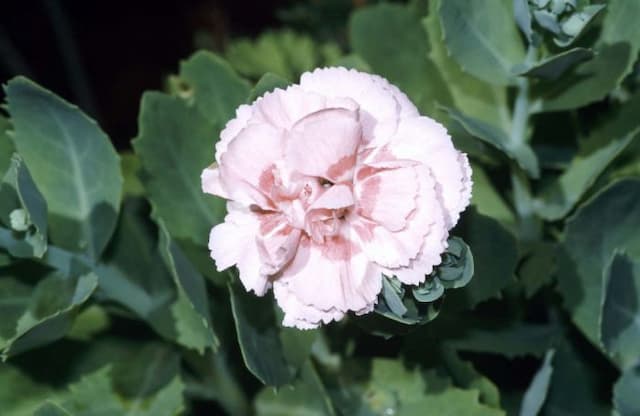Pink Dianthus 'Devon Siskin' (p)

ABOUT
Dianthus 'Devon Siskin' is a visually distinctive plant characterized by its vibrant and showy flowers. The blooms typically display a rich palette of pinks, ranging from soft pastels to deeper hues. Each flower is neatly edged, creating a frilly or ruffled appearance that adds to their ornate charm. These blossoms are often arranged in tight clusters, providing a generous splash of color. The petals of Dianthus 'Devon Siskin' are known for their elegant pattern, often with a contrasting eye or a distinctively marked center which draws attention to the intricate designs within each floret. This eye-catching detail is one of the hallmarks of the variety, imparting a sense of depth and complexity to the overall floral display. The foliage of Dianthus 'Devon Siskin' forms a dense and tidy mound beneath the flowers. The leaves exhibit a slender, linear shape and possess a blue-green or gray-green color that contrasts beautifully with the bright flowers. The texture of the leaves is typically smooth with a waxy or leathery feel that adds yet another layer of interest to the plant's appearance. Though compact, Dianthus 'Devon Siskin' has a presence that belies its size, with its striking blooms and attractive foliage making it a popular choice for gardeners seeking to add a touch of elegance and color to their landscape. The overall impression of Dianthus 'Devon Siskin' is one of delicate beauty and refined sophistication, perfect for a variety of garden settings and containers.
About this plant
 Names
NamesFamily
Caryophyllaceae
Synonyms
Devon Siskin Pink, Cheddar Pink, Carnation, Sweet William
Common names
Dianthus 'Devon Siskin'
 Toxicity
ToxicityTo humans
Dianthus 'Devon Siskin', commonly known as Pink, is not considered toxic to humans. It does not typically cause any adverse effects if touched or accidentally ingested in small quantities. However, as with any plant, individual reactions can vary, and it's always best to avoid ingesting parts of ornamental plants as a precaution.
To pets
Pink, the common name for Dianthus 'Devon Siskin', is generally considered non-toxic to pets. While it is not known for causing serious toxicity issues, ingestion in significant amounts could potentially cause mild gastrointestinal upset in some animals. Always monitor pets around plants and consult with a veterinarian if unusual symptoms appear after ingestion.
 Characteristics
CharacteristicsLife cycle
Perennials
Foliage type
Evergreen
Color of leaves
Blue-green
Flower color
Yellow
Height
1 feet 4 inches (0.4 meters)
Spread
1 feet (0.3 meters)
Plant type
Herb
Hardiness zones
7
Native area
Europe
Benefits
 General Benefits
General Benefits- Ornamental Appeal: Adds aesthetic value to gardens with its attractive flowers and foliage.
- Long Blooming Season: Offers a prolonged display of color with a long flowering period.
- Drought Tolerance: Once established, it can tolerate periods of low water, making it suitable for xeriscaping.
- Low Maintenance: Requires minimal care beyond basic watering and occasional feeding.
- Cold Hardy: Capable of surviving in cooler climates and resistant to frost damage.
- Attracts Pollinators: Flowers are known to attract bees and butterflies, promoting pollination in the garden.
- Compact Growth: Ideal for small spaces, borders, and container gardening due to its tidy growth habit.
 Medical Properties
Medical PropertiesThis plant is not used for medical purposes.
 Air-purifying Qualities
Air-purifying QualitiesThis plant is not specifically known for air purifying qualities.
 Other Uses
Other Uses- Dye Production: The petals of the Dianthus 'Devon Siskin', commonly known as Pink, can be used to create a natural dye for fabrics, offering hues ranging from light pink to a more intense reddish color depending on the mordant used.
- Bookmarks: Dried petals or even pressed whole flowers of Pink can be laminated or placed between clear sheets to create unique and fragrant bookmarks.
- Candle Making: The petals of Pink can be incorporated into candle wax to add a decorative element and a subtle fragrance when the candle burns.
- Culinary Garnish: The edible flowers of Pink can be used as a colorful and edible garnish for salads, desserts, and cocktails, adding a touch of elegance and a mild spicy flavor to dishes.
- Plant Dye for Art: The Pink's natural pigments can be used by artists as a botanical dye in watercolor painting or fabric arts, providing an organic alternative to synthetic dyes.
- Flower Confetti: The petals of Pink can be dried and used as a biodegradable confetti for weddings, celebrations, or as a decorative topping for gift wrapping or craft projects.
- Potpourri Ingredient: Dried petals of Pink can contribute color, texture, and a mild fragrance to homemade potpourri mixes.
- Floral Bath Sachets: The petals and buds of Pink can be sewn into small fabric sachets and used to infuse bath water with subtle fragrance and soften the skin.
- Homemade Paper: When making paper from scratch, bits of Pink flowers can be added to the pulp to create a floral pattern within the paper which is great for stationary or special occasion cards.
- Natural Pest Deterrent: While not a primary use, the aromatic properties of Pink flowers can sometimes help deter certain insects when planted in the garden or when petals are placed around outdoor seating areas.
Interesting Facts
 Feng Shui
Feng ShuiThe Dianthus is not used in Feng Shui practice.
 Zodiac Sign Compitability
Zodiac Sign CompitabilityThe Dianthus is not used in astrology practice.
 Plant Symbolism
Plant Symbolism- Love: Dianthus flowers in general are associated with love due to their enduring and attractive blooms, underscoring both romantic and platonic bonds.
- Admiration: The vibrant and eye-catching appearance of the Dianthus 'Devon Siskin' can symbolize admiration, reflecting the esteem one person holds for another.
- Passion: The bright colors of this plant often suggest deep feelings and passion, making it a suitable representation of strong emotional connections.
- Divine Favor: In historic symbolism, Dianthus is sometimes associated with the gods, implying that the 'Devon Siskin' variant could be seen as a sign of divine approval or blessings.
- Purity: As with many flowers, Dianthus varieties can represent purity, with the 'Devon Siskin' potentially signaling innocence or virtuousness in its pristine character.
 Water
WaterCarnations should be watered deeply but not too frequently, allowing the soil to dry slightly between waterings. Typically, watering once a week with one inch of water is adequate, but this may vary depending on weather conditions such as heat and wind which could increase the need for water. Adjust the schedule to ensure the soil remains moist but never waterlogged, as excess water can lead to root rot. During the summer months or in dry climates, watering may need to increase to twice per week, especially if the plant is in a container. Always water at the base of the plant to avoid wetting the foliage, which can encourage disease.
 Light
LightCarnations thrive best in full sun, meaning they require at least six hours of direct sunlight per day. The ideal spot for planting carnations would be a location where they can enjoy bright, unfiltered sunlight throughout the day. However, in extremely hot climates, they can benefit from light afternoon shade to protect them from scorching midday sun.
 Temperature
TemperatureCarnations prefer cooler temperatures and can typically survive in temperatures as low as 40°F without sustaining damage. Their ideal growing temperature ranges between 60°F to 70°F. It's important to avoid exposing carnations to temperatures above 85°F for extended periods, as this can cause stress and inhibit flowering.
 Pruning
PruningCarnations should be pruned to encourage bushier growth and more blooms. Deadheading, or removing spent flowers, should be done regularly to promote continuous flowering. The best time to prune back carnations is in late winter or early spring before new growth begins. You can cut back the stems by one-third to one-half to keep the plant compact and healthy.
 Cleaning
CleaningAs needed
 Soil
SoilThe best soil mix for the Pinks (common name for Dianthus 'Devon Siskin') should be well-draining and rich in organic matter, with a slightly alkaline pH level of 7.0 to 7.5. A mix of two parts loam, one part sand, and one part compost or aged manure would be ideal.
 Repotting
RepottingPinks should be repotted every 1-2 years to refresh the soil and accommodate root growth. Repot in spring before the onset of vigorous growth.
 Humidity & Misting
Humidity & MistingPinks thrive in moderate humidity conditions. They do not require high humidity; average room humidity or outdoor ambient humidity is sufficient for healthy growth.
 Suitable locations
Suitable locationsIndoor
Place in bright light with some direct sun and ensure good airflow.
Outdoor
Plant in full sun to partial shade with well-draining soil.
Hardiness zone
4-9 USDA
 Life cycle
Life cycleDianthus 'Devon Siskin', commonly known as pink or carnation, typically begins its life as a seed, which will germinate under appropriate conditions of warmth and moisture. Upon germination, the seedlings emerge and grow, developing a basic root system and foliage in the form of blue-green grass-like leaves. As the plant matures, it forms a sturdy stem and a profusion of flowers that can range in color, often displaying frilled edges with a sweet fragrance. After pollination, which can be facilitated by insects or wind, the flowers will produce seeds that mature within a capsule-like structure. Once the seeds are fully developed, the plant disperses them into the surrounding environment to facilitate the next generation's growth. With appropriate care like full sun exposure and well-drained soil, Dianthus 'Devon Siskin' can enjoy a perennial life cycle, returning each year to bloom again.
 Propogation
PropogationPropogation time
Spring-Early Summer
The Dianthus 'Devon Siskin', commonly known as Pink, is typically propagated by cuttings. The best time for taking cuttings is in late spring to early summer when the plant's new growth is vigorous and plentiful. To propagate Pinks through cuttings, a gardener would select a healthy stem with a few leaves and cut it from the parent plant just below a leaf node, about 2-4 inches in length (5-10 cm). The lower leaves should be carefully removed and the cut end dipped in rooting hormone powder to encourage root development. Afterward, the cutting is inserted into a moistened soilless potting mix or perlite and kept under high humidity with consistent but not direct sunlight. Roots typically form within a few weeks, at which point the new Pink can be transplanted to a more permanent location. This method of propagation helps maintain the purity of the cultivar's characteristics, ensuring that the offspring closely resemble the parent plant.



![Pink [Tequila Sunrise]](/_next/image?url=https%3A%2F%2Fplants-admin.emdemapps.com%2Fimages%2Fplants%2F%2Fimages%2F604b5d995d06e.png&w=640&q=75)





